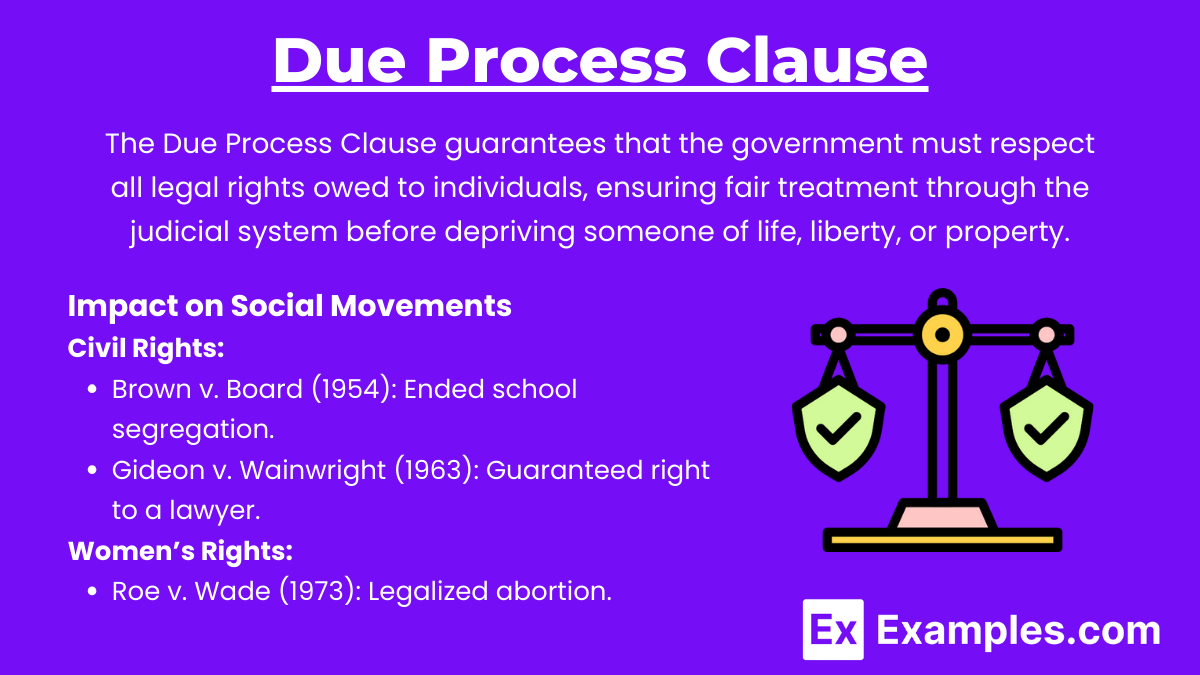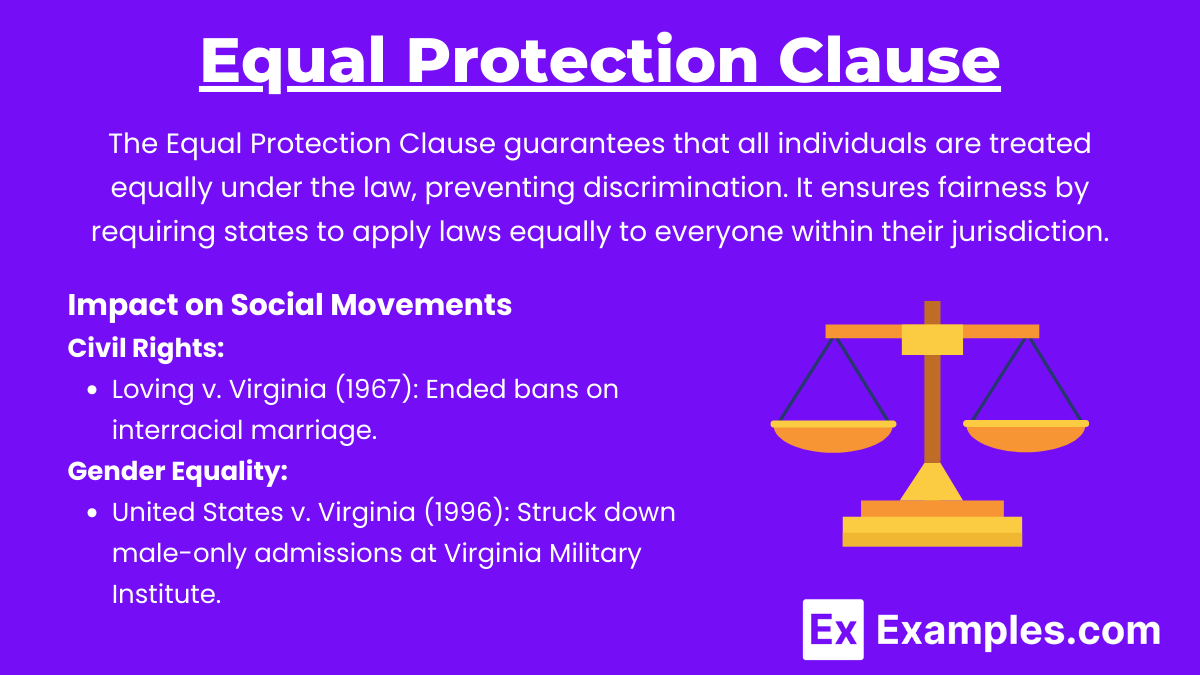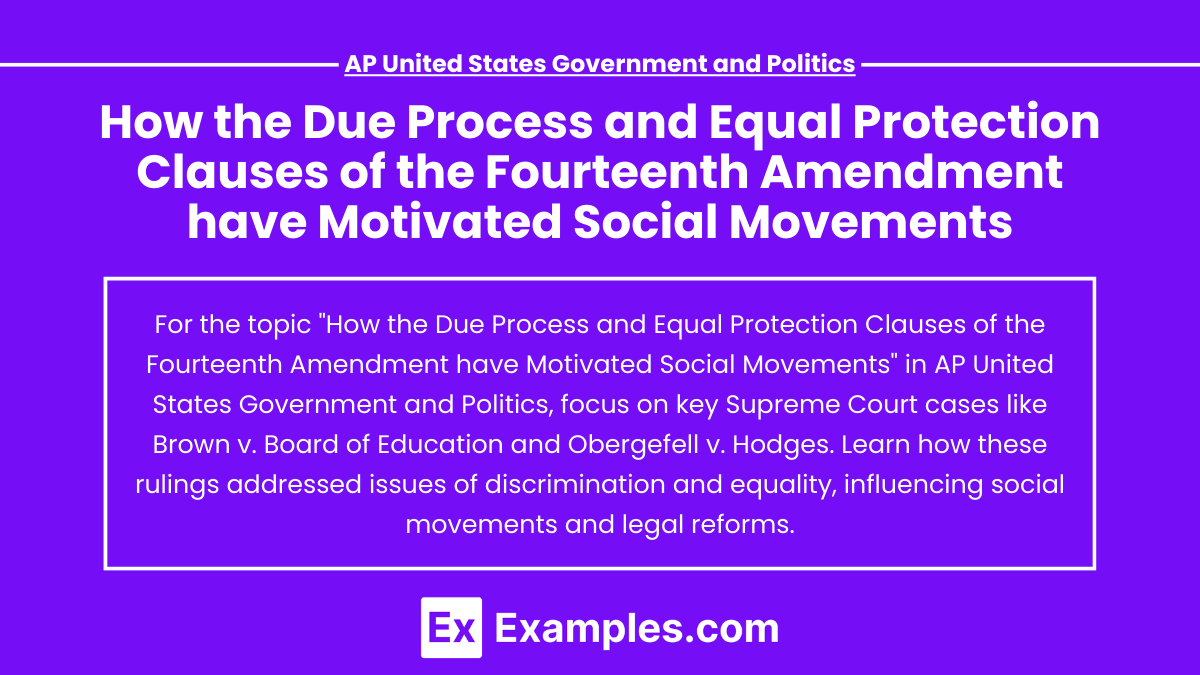The Due Process and Equal Protection Clauses of the Fourteenth Amendment have been pivotal in motivating social movements throughout American history. These constitutional provisions have empowered activists to challenge discriminatory practices and advocate for equal rights. Landmark Supreme Court decisions, such as Brown v. Board of Education, Roe v. Wade, and Obergefell v. Hodges, have utilized these clauses to advance civil rights, dismantle segregation, and affirm marriage equality, driving significant legal and societal changes in the pursuit of justice and equality.
Learning Objectives
For the topic “How the Due Process and Equal Protection Clauses of the Fourteenth Amendment have Motivated Social Movements” in AP United States Government and Politics, you should learn to identify key Supreme Court cases that have utilized these clauses to drive social change, such as Brown v. Board of Education, Roe v. Wade, Loving v. Virginia, and Obergefell v. Hodges. Understand how these clauses have been applied to challenge issues like racial segregation, gender discrimination, and LGBTQ+ rights, leading to significant legal and social advancements. Analyze the impact of these rulings on various social movements and evaluate how they have influenced legal standards and societal attitudes toward equality and justice.
The Fourteenth Amendment, ratified in 1868, is a cornerstone of civil rights in the United States. It contains several key clauses, but the Due Process Clause and the Equal Protection Clause are particularly significant in shaping social movements. These clauses have been instrumental in advancing civil rights by providing a constitutional foundation for challenging discriminatory practices and advocating for equal treatment under the law.
1. Due Process Clause

Text of the Clause
The Due Process Clause states: “No state shall deprive any person of life, liberty, or property, without due process of law.”
Impact on Social Movements
- Civil Rights Movement:
- Brown v. Board of Education (1954): This landmark case challenged racial segregation in public schools, arguing that separate facilities were inherently unequal and violated the Due Process Clause. The Court’s ruling that segregation was unconstitutional helped galvanize the Civil Rights Movement, leading to further desegregation and equality efforts.
- Gideon v. Wainwright (1963): The Court ruled that the Due Process Clause guarantees the right to legal counsel for defendants in criminal cases who cannot afford an attorney. This decision expanded access to justice and was a significant victory for the rights of the accused.
- Women’s Rights Movement:
- Roe v. Wade (1973): This decision recognized a woman’s constitutional right to privacy under the Due Process Clause, legalizing abortion. The ruling was a crucial moment in the women’s rights movement, shaping the ongoing debate over reproductive rights.
- LGBTQ+ Rights Movement:
- Obergefell v. Hodges (2015): The Supreme Court ruled that same-sex marriage is a constitutional right under the Due Process Clause. This decision was a monumental victory for LGBTQ+ rights, affirming the legal equality of same-sex couples.
2. Equal Protection Clause

Text of the Clause
The Equal Protection Clause states: “No state shall deny to any person within its jurisdiction the equal protection of the laws.”
Impact on Social Movements
- Civil Rights Movement:
- Loving v. Virginia (1967): The Court struck down laws banning interracial marriage, ruling that such laws violated the Equal Protection Clause. This case was a pivotal moment in the fight against racial discrimination and contributed to broader civil rights gains.
- Gender Equality:
- United States v. Virginia (1996): The Court ruled that the male-only admissions policy at the Virginia Military Institute violated the Equal Protection Clause. This case advanced gender equality in education and military service.
- Disability Rights Movement:
- City of Cleburne v. Cleburne Living Center (1985): The Supreme Court ruled that a zoning ordinance that excluded a group home for individuals with intellectual disabilities violated the Equal Protection Clause. This decision supported the rights of people with disabilities and challenged discriminatory practices.
Examples
Example 1 : Brown v. Board of Education (1954)
In Brown v. Board of Education, the Supreme Court addressed the issue of racial segregation in public schools. The plaintiffs argued that segregation violated the Equal Protection Clause of the Fourteenth Amendment by creating unequal educational opportunities. The Court’s decision that “separate but equal” was inherently unequal was a significant victory for the Civil Rights Movement. This ruling helped dismantle institutionalized segregation and provided a crucial legal precedent for further civil rights reforms, fueling activism and legislative changes aimed at achieving racial equality.
Example 2 : Roe v. Wade (1973)
Roe v. Wade was a landmark Supreme Court decision that recognized a woman’s constitutional right to privacy under the Due Process Clause of the Fourteenth Amendment. The ruling effectively legalized abortion nationwide and was a major victory for the women’s rights movement. By affirming that women have the right to make decisions about their own reproductive health, the decision mobilized advocates for women’s reproductive rights and set the stage for ongoing debates and legal battles over abortion access and women’s autonomy.
Example 3 : Loving v. Virginia (1967)
In Loving v. Virginia, the Supreme Court struck down state laws banning interracial marriage, ruling that such laws violated the Equal Protection Clause of the Fourteenth Amendment. This case was pivotal for the Civil Rights Movement, challenging racial discrimination and affirming the right to marry regardless of race. The decision marked a significant victory for racial equality and was instrumental in dismantling institutional racial barriers, supporting broader efforts to combat racial discrimination and promote civil rights.
Example 4 : Obergefell v. Hodges (2015)
The Supreme Court’s decision in Obergefell v. Hodges legalized same-sex marriage nationwide, ruling that state bans on same-sex marriage violated the Due Process and Equal Protection Clauses of the Fourteenth Amendment. This landmark ruling was a monumental victory for the LGBTQ+ rights movement, affirming the legal equality of same-sex couples and driving social acceptance and legislative support for LGBTQ+ rights. The decision represented a significant advancement in the fight for marriage equality and broader LGBTQ+ civil rights.
Example 5 : United States v. Virginia (1996)
In United States v. Virginia, the Supreme Court ruled that the Virginia Military Institute’s male-only admissions policy violated the Equal Protection Clause of the Fourteenth Amendment. The case challenged gender discrimination in higher education and led to the Court’s conclusion that excluding women from VMI was unconstitutional. This decision advanced gender equality by ensuring that women had equal access to educational opportunities and set a precedent for addressing gender discrimination in various institutions, supporting the broader gender equality movement.
Multiple Choice Questions
Question 1:
Which Supreme Court case utilized the Due Process Clause of the Fourteenth Amendment to establish a constitutional right to privacy for women?
A) Loving v. Virginia
B) Roe v. Wade
C) Brown v. Board of Education
D) United States v. Virginia
Answer: B) Roe v. Wade
Explanation:
Roe v. Wade (1973) is the landmark Supreme Court case that used the Due Process Clause of the Fourteenth Amendment to establish a constitutional right to privacy concerning a woman’s decision to have an abortion. The Court ruled that this right to privacy extends to a woman’s choice to terminate a pregnancy, thereby legalizing abortion across the United States and significantly impacting the women’s rights movement.
Question 2:
Which Supreme Court decision declared that state bans on interracial marriage violated the Equal Protection Clause of the Fourteenth Amendment?
A) Obergefell v. Hodges
B) Brown v. Board of Education
C) Loving v. Virginia
D) Gideon v. Wainwright
Answer: C) Loving v. Virginia
Explanation:
Loving v. Virginia (1967) was a pivotal Supreme Court case that invalidated state laws prohibiting interracial marriage. The Court ruled that these bans violated the Equal Protection Clause of the Fourteenth Amendment by denying individuals the right to marry based on race. This decision was a crucial victory for the Civil Rights Movement and helped dismantle legal barriers to racial equality.
Question 3:
How did the Supreme Court’s decision in Obergefell v. Hodges (2015) use the Fourteenth Amendment to advance LGBTQ+ rights?
A) It upheld state bans on same-sex marriage.
B) It declared that same-sex couples had a constitutional right to marry.
C) It mandated gender quotas in public schools.
D) It enforced stricter immigration laws for same-sex couples.
Answer: B) It declared that same-sex couples had a constitutional right to marry.
Explanation:
Obergefell v. Hodges (2015) used both the Due Process and Equal Protection Clauses of the Fourteenth Amendment to affirm that same-sex marriage is a constitutional right. The Supreme Court ruled that state bans on same-sex marriage violated these clauses by denying same-sex couples the same legal recognition and protections afforded to opposite-sex couples. This landmark decision was a significant milestone in the LGBTQ+ rights movement, ensuring marriage equality nationwide.


